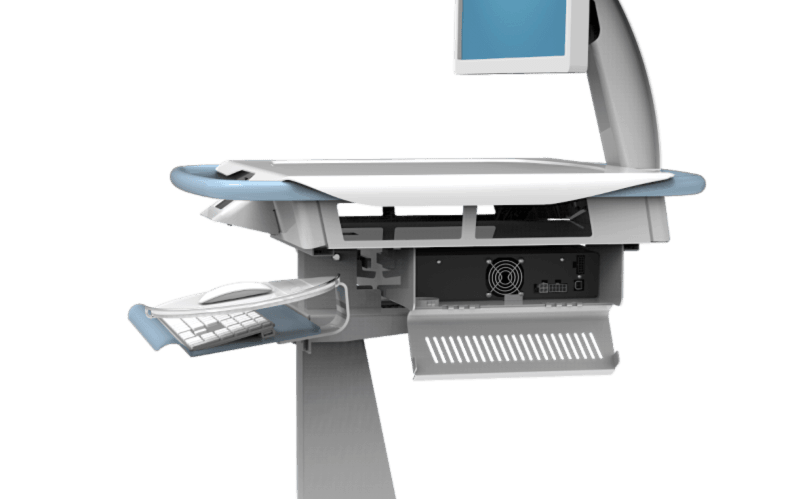The 3 reasons batteries lose capacity, 3 ways Jaco slows the process, and 3 ways you can maximize your battery life
Batteries replacement takes up the lion’s share of downstream supply chain costs associated with powered EHR carts. So it’s no wonder that our customers frequently ask us: What can we do to prolong battery life?
First, it helps to understand what we’re working against.
Why batteries lose capacity
Age. Any battery will eventually lose capacity over time. All other things being equal, some battery types lose capacity faster than others.
Elevated temperature. In general, the higher the temperature of the battery environment, the faster the battery will lose capacity, particularly when the battery is highly charged. Some battery types are more resistant to heat-related capacity loss than others.
Cycling. Cycling is the process of recharging a battery, and then discharging it under a workload. In the case of EHR carts, the workload is the power draw of the PC hardware and peripherals on the cart. Overcharging, overheating, and full discharge of the battery are all cycling-related events that can shorten the battery life.
How Jaco ‘designs’ longer battery life into our carts
At first glance, a Jaco cart’s power system might not seem different from the power system on any other cart. But every Jaco powered EHR cart includes unique design features specifically intended to prolong battery life (as well as maximize battery safety).
Lithium iron phosphate (LiFePO4) batteries. Jaco selected LiFePO4 batteries for all its powered carts, because compared to other rechargeable battery chemistries, LiFePO4 is best suited to hospital use. Specifically:
- LiFePO4 is safer. Unlike other lithium battery chemistries, LiFePO4 is not vulnerable to thermal runaway while charging, or when fully charged. Thermal runaway is a chief cause of fires in other battery types.
- LiFePO4 delivers up to 4x the cycle life. Jaco’s LiFePO4 batteries are warrantied for 4,000 cycles, whereas other lithium-based EHR cart batteries lose significant capacity after 1,000 to 1,600 cycles.
- LiFePO4 can take the heat. LiFePO4 is less susceptible to heat-related capacity loss than other lithium-ion (Li-ion) batteries, and much less susceptible to heat-related capacity loss than sealed lead acid (SLA) batteries.
- LiFePO4 supports good charging habits. LiFePO4 maintains its capacity even when the cart is plugged in for long periods of time (see ‘Plug in carts when practical’ below).
- LiFePO4 has a low self-discharge rate. Fully-charged LiFePO4 batteries can sitting idle for a time, and not need to be recharged again before use.
Intelligent charging. Jaco’s inverter/charger contains built-in intelligence to prevent overcharging, and to precisely control the rate of charging to prevent overheating. In addition, every battery contains intelligence to prevent over overheating, the unlikely event that the inverter/charger functions improperly.
To help prevent batteries from discharging fully, the on-cart power indicator’s ‘discharged’ warning is premature, to encourage recharging before the battery is fully discharged.
Batteries separated from the inverter/charger. In most powered carts, the batteries and the inverter charger are enclosed together, usually in the base of the cart. This is a sub-optimal arrangement, because the inverter/charger throws a certain amount of heat in the normal course of its operation. It’s also potentially dangerous: Dust and dirt from the floor can clog or damage the inverter/charger’s cooling system, creating an even higher-temperature environment for the battery that can accelerate capacity loss or, worse, lead to dangerous battery fires.
For these reasons, Jaco separates the batteries from the inverter/charger – the batteries are in the base of the cart, and the inverter/charger is mounted higher on the cart, either under or behind the electronics bay. This keeps the batteries cooler, which helps them last longer, and virtually eliminates the possibility of an inverter/charger-related battery fire. As a bonus, Jaco’s elevated inverter/charger requires a lot less maintenance (because it stays cleaner) and is a lot easier to reach.

Jaco positions the inverter/charger high on the cart, separate from the batteries – which keeps the batteries cooler, the inverter/charger cleaner, and everybody safer.
What you can do: Best practices for longer battery life
We’ve done our part. Here are very simple best practices you can follow to get the longest possible service from your Jaco batteries:
Use energy-efficient hardware with ‘sleep’ and/or ‘eco’ modes. Shop for the most energy-efficient (low-draw) computing devices that meet your EHR workflow requirement. Then, configure the PC and monitor to ‘sleep’ when not in use – which can reduce the draw on your batteries by 90% or more. (Always work with your nursing staff to make sure sleep mode timing does not interrupt workflow or otherwise interfere with care delivery.)
Periodically check the electronics cooling system. Again, Jaco’s elevated inverter/charger is much less vulnerable to damage than base-mounted alternatives. But you should still check the system periodically to be sure the cooling system isn’t blocked by dust or dirt. If you use a compressed air canister to clean the cart’s electronics bay, be sure to apply very light pressure, to avoid damaging the inverter/charger’s components.
Plug in carts when practical. The simplest way to avoid damaging full discharge is to ‘top-off’ batteries when practical – for example, when the cart is not in use. Note that this is not necessarily recommended for non-Jaco or non-LiFePO4 batteries, which may overheat or lose capacity when plugged in while fully charged.

